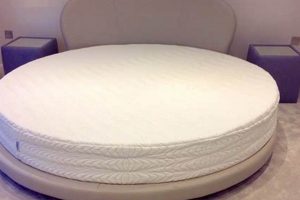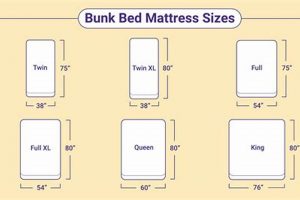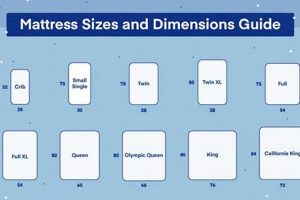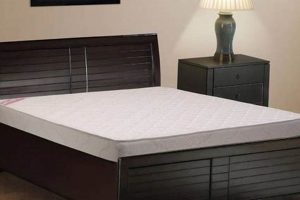A non-standard mattress size, often referred to as a three-quarter mattress, falls between a twin and a full mattress in dimensions. Typically measuring around 48 inches wide and 75 inches long, it offers a sleeping surface suitable for a single sleeper, potentially within a smaller bedroom or living space. This size is sometimes also used in antique bed frames.
Historically, this mattress dimension provided an economical option for accommodating individuals in shared living quarters, or spaces where a full-size bed was impractical. The size allows for a more spacious sleep than a twin, while consuming less floor area than a full. The relative rarity of this dimension in modern times means sourcing appropriate bedding and frames may require specialized retailers or custom orders. Benefits can include maximized space efficiency, particularly in older homes or apartments, and retaining a historical aesthetic when used with antique bed frames.
The subsequent sections will examine specific considerations for purchasing this particular mattress dimension, including factors like available frame options, suitable sleeping arrangements, and the potential challenges of finding readily available bedding.
Essential Guidance for Selecting a Three-Quarter Bed Mattress
Considerations for acquiring a mattress of this particular size warrant careful assessment given its non-standard dimensions. The following recommendations offer pertinent information to aid in a judicious purchasing decision.
Tip 1: Measure the Intended Space: Prior to purchase, meticulously measure the available area in the room. Ensure sufficient clearance for movement around the bed and any adjacent furniture.
Tip 2: Verify Frame Compatibility: The frame must precisely match the mattress dimensions to prevent shifting and ensure adequate support. Custom frames may be required depending on availability.
Tip 3: Assess Sleeper Needs: A single sleeper of average build will generally find this size adequate. Larger individuals, or those who prefer ample space, should explore larger options.
Tip 4: Research Bedding Availability: Standard bedding sets may not readily accommodate this size. Budget for custom-made or adapted bedding to ensure a proper fit and aesthetic appeal.
Tip 5: Consider Mattress Type: Evaluate the various mattress types, such as innerspring, memory foam, or latex, based on preferred firmness and support. The same considerations applicable to standard sizes apply here.
Tip 6: Check for Custom Options: Given the non-standard nature of this size, explore manufacturers offering customized mattress dimensions. This ensures a perfect fit and tailored comfort.
Adherence to these guidelines will facilitate a satisfactory procurement of a mattress meeting both spatial and comfort requirements. A well-informed decision will maximize both the utility and longevity of the selected product.
The subsequent section will address common questions related to the selection, maintenance, and longevity of a three-quarter size bed mattress.
1. Dimensions
The designation “3/4 bed mattress” is intrinsically linked to its approximate dimensions of 48 inches in width and 75 inches in length. These measurements define the physical parameters of the mattress, directly influencing its suitability for specific applications. For example, the reduced width compared to a full-size mattress makes it a practical solution for smaller bedrooms where space is a premium. The length, consistent with a standard twin, generally accommodates a single adult comfortably. The cause-and-effect relationship here is clear: the chosen dimensions dictate the utility of the mattress in different spatial contexts.
Understanding these dimensions is critical for several practical reasons. When purchasing, accurate measurements allow for proper frame selection. A frame not designed for these specific dimensions can lead to inadequate support and accelerated mattress wear. Bedding is another key consideration. Standard bedding sets are typically designed for twin, full, queen, or king sizes. Therefore, acquiring appropriately sized sheets and blankets for a 3/4 bed mattress often requires specialized ordering or alteration, further underscoring the practical significance of knowing the exact dimensions.
In conclusion, the 48″ x 75″ dimensions are not merely descriptive but are fundamental to the very definition and functionality of the 3/4 bed mattress. These measurements dictate its niche application in space-constrained environments, influence frame compatibility, and necessitate careful consideration of bedding options. A comprehensive understanding of these dimensions is crucial for ensuring a satisfactory and practical purchase.
2. Space Optimization
The principle of space optimization is a primary driver in the selection of a three-quarter bed mattress. Its dimensions offer a targeted solution for environments where maximizing available area is paramount. This consideration is particularly relevant in smaller bedrooms, apartments, or historical properties where existing room sizes may be limited.
- Footprint Reduction
A mattress of this size occupies less floor space than a standard full or double mattress. This reduction allows for greater freedom of movement within the room and facilitates the incorporation of additional furniture or storage solutions. Examples include small apartments, guest rooms, or children’s rooms where play areas are desired. The smaller footprint directly translates to enhanced usability of the overall space.
- Adaptability to Restricted Areas
Certain architectural designs or pre-existing room layouts may inherently restrict the size of furnishings. A three-quarter mattress offers a viable bedding solution in these scenarios, providing a comfortable sleeping surface without compromising the room’s functionality. This is especially pertinent in older homes or converted spaces where standard mattress sizes may prove incompatible. The adaptability stems from the reduced width, allowing placement where a full-size bed would be impractical.
- Efficient Utilization of Vertical Space
When paired with appropriate bed frames or platforms, a three-quarter mattress can facilitate the utilization of vertical space. Storage drawers beneath the bed, or lofted arrangements, become more feasible due to the mattress’s reduced footprint. This allows for the efficient organization of belongings and minimizes clutter within the room. The resulting effect is a more streamlined and aesthetically pleasing environment.
- Enhanced Room Proportionality
In smaller rooms, using oversized furniture can create an imbalance in visual proportionality, making the space feel cramped and uncomfortable. A three-quarter mattress, by virtue of its smaller dimens
ions, maintains a more harmonious relationship with the overall room size. This contributes to a greater sense of spaciousness and a more balanced aesthetic. For example, utilizing the bed in studio apartments.
The facets outlined above highlight the integral relationship between the choice of a three-quarter bed mattress and the overarching goal of space optimization. By carefully considering the physical dimensions of the mattress and its potential impact on room functionality, informed decisions can be made to ensure efficient use of space and a comfortable living environment. In essence, this particular size offers a strategic compromise between comfort and spatial efficiency.
3. Single Sleeper
The three-quarter bed mattress inherently caters to a single sleeper, defining the optimal usage scenario for this dimension. Its design directly addresses the needs and spatial requirements of one individual, influencing comfort, support, and overall suitability. The limited surface area necessitates a thoughtful alignment between mattress size and the physical characteristics of the intended user.
- Optimal Size for One
The dimensions are generally suited to comfortably accommodate a single adult of average build. The available space provides sufficient room for movement during sleep without excessive unused surface area. A larger individual may experience limitations in comfort, potentially affecting sleep quality. For instance, a taller person may find their feet extending beyond the mattress edge.
- Space Efficiency for Single Occupancy
In environments intended for single occupancy, such as small apartments, dorm rooms, or guest rooms, the three-quarter mattress maximizes available space while providing a dedicated sleeping area. This contrasts with larger mattresses that, while offering greater sleeping surface, may compromise the overall functionality of the room. Space efficiency becomes a key advantage in these situations.
- Cost-Effectiveness for Individuals
A three-quarter mattress generally presents a more economical option compared to full or queen-sized mattresses. This is due to reduced material usage and potentially lower manufacturing costs. For individuals seeking a budget-conscious solution without sacrificing basic comfort, this mattress size offers a viable compromise. This is beneficial for students or those furnishing a starter home.
- Minimal Disturbance Potential
Designed for single occupancy, the three-quarter mattress eliminates the potential for sleep disturbance caused by a partner’s movements or restlessness. This contributes to a more consistent and undisturbed sleep experience, particularly beneficial for light sleepers or individuals with sleep disorders. This is in comparison to sharing a larger mattress and experiencing such disturbances.
In summary, the relationship between a three-quarter bed mattress and a single sleeper is one of functional optimization. The mattress dimensions, space-saving characteristics, and cost-effectiveness align to provide a targeted solution for individuals seeking a comfortable and practical sleep environment. The absence of a second sleeper further enhances the benefits in terms of undisturbed rest and efficient space utilization.
4. Frame Availability
The availability of bed frames designed specifically for three-quarter mattresses presents a significant consideration for potential purchasers. The non-standard size of these mattresses often results in limited options compared to more common dimensions such as twin, full, queen, or king. This constraint directly influences the ease of acquisition and the overall cost of establishing a complete bedding setup.
- Limited Retail Selection
The stock of three-quarter bed frames at major furniture retailers tends to be scarce. Inventory constraints stem from lower consumer demand for this size. Consequently, buyers may encounter difficulty finding suitable frames in physical stores, necessitating online searches or specialized orders. The reduced selection limits stylistic choices and immediate availability.
- Specialized Manufacturers and Antique Dealers
Sources for frames often include smaller, specialized manufacturers that cater to non-standard sizes, or antique dealers offering vintage frames originally designed for three-quarter mattresses. These avenues may provide suitable options, but can also involve higher costs or the need for restoration work. Custom fabrication represents another solution, albeit at a potentially significant expense.
- Modification of Existing Frames
In some instances, it may be possible to modify a readily available frame from a different size to accommodate a three-quarter mattress. This approach requires careful measurements and potentially professional carpentry work to ensure structural integrity and proper mattress support. The feasibility of modification depends on the design of the original frame and the availability of skilled labor.
- Impact on Bedding Support and Longevity
An ill-fitting frame can negatively impact the support and longevity of the mattress. Inadequate support can lead to uneven wear, sagging, and a reduced lifespan. It can also compromise the sleeper’s comfort and potentially contribute to back pain or other physical ailments. Therefore, ensuring proper frame compatibility is critical for maintaining both the mattress and the sleeper’s well-being.
The limited frame availability for three-quarter bed mattresses underscores the importance of proactive research and careful planning. Potential buyers should thoroughly investigate frame options, consider the costs associated with specialized manufacturing or modification, and prioritize proper support to ensure a satisfactory and long-lasting bedding solution. Ignoring frame compatibility issues can lead to avoidable expenses and diminished sleep quality.
5. Bedding Challenges
Acquiring appropriate bedding for a three-quarter bed mattress presents a distinct set of challenges arising from its non-standard dimensions. The limited availability of specifically sized sheets, blankets, and comforters necessitates proactive research and, often, custom solutions. These constraints directly impact convenience, cost, and aesthetic considerations.
- Sourcing Difficulties
Standard bedding sets are primarily manufactured for twin, full, queen, and king-sized mattresses. Consequently, finding pre-made bedding that precisely fits a three-quarter mattress requires significant effort. Major retailers typically offer limited, if any, options in this size, forcing consumers to rely on online marketplaces, specialty stores, or custom tailoring services. Sourcing difficulty leads to increased time investment and reduced purchasing flexibility.
- Increased Costs
The need for custom-made bedding inevitably elevates expenses. Tailoring sheets, blankets, or comforters to the precise dimensions of a three-quarter mattress involves additional labor and materia
l costs compared to purchasing standard-sized items. Furthermore, specialty stores catering to non-standard sizes often command premium prices due to reduced production volumes and niche market positioning. Cost considerations become a significant factor in the overall bedding acquisition process. - Fit and Aesthetic Compromises
Attempting to use standard-sized bedding on a three-quarter mattress typically results in a compromised fit. Oversized sheets can bunch or drag, creating discomfort and detracting from the bed’s appearance. Undersized bedding, conversely, may fail to adequately cover the mattress, exposing it to wear and tear. These compromises necessitate either accepting a less-than-ideal aesthetic or investing in alterations to achieve a proper fit.
- Material and Style Limitations
The limited availability of three-quarter sized bedding often translates to fewer choices in terms of fabric types, colors, and patterns. Custom tailoring services may impose restrictions on available materials or designs, further limiting the consumer’s ability to personalize their bedding to match their desired aesthetic. This restriction can be particularly frustrating for individuals with specific design preferences or sensitivities to certain materials.
The challenges outlined above underscore the practical considerations associated with acquiring bedding for a three-quarter bed mattress. The scarcity of standard-sized options necessitates proactive sourcing, increased financial investment, and potential compromises in fit and aesthetic preferences. Recognizing these constraints is crucial for informed decision-making and successful acquisition of appropriate bedding solutions.
6. Support Requirements
The correlation between the dimensions of a three-quarter bed mattress and its inherent support requirements is direct. Given that this mattress size is primarily intended for a single sleeper, its internal construction must adequately distribute the sleepers weight to prevent sagging and ensure proper spinal alignment. Inadequate support can lead to discomfort, disturbed sleep, and, over time, potential musculoskeletal issues. The construction materials and designcoil systems, foam density, or a hybrid of bothmust be chosen to effectively withstand consistent pressure in the areas where weight is concentrated. For example, a lightweight individual may find a softer mattress sufficient, while a heavier individual will necessitate a firmer mattress with enhanced internal support structures.
The type of bed frame utilized significantly influences the mattresss overall support. Frames with widely spaced slats, or those lacking a central support beam, may cause premature wear and tear, even on a new mattress. In contrast, a solid platform bed or a frame with closely spaced slats provides a more stable and even foundation, thereby maximizing the mattress’s lifespan and maintaining its intended level of support. Regularly inspecting the frame for signs of damage or weakness is critical, as a compromised frame undermines the mattress’s ability to deliver adequate support, irrespective of its internal construction. For example, a broken slat can cause localized sagging, leading to uneven weight distribution and discomfort.
In conclusion, understanding and addressing the specific support requirements of a three-quarter bed mattress is crucial for ensuring both its longevity and the sleeper’s comfort. Selecting a mattress with appropriate internal construction and pairing it with a sturdy, supportive frame are essential steps. Neglecting these considerations can result in premature mattress degradation and potential negative impacts on the sleeper’s health and well-being. Prioritizing support is therefore not merely a matter of preference, but a fundamental requirement for maximizing the value and functionality of this particular mattress size.
7. Comfort Preferences
The subjective nature of comfort preferences exerts a significant influence on the suitability of a three-quarter bed mattress for individual users. While the dimensions of this mattress size inherently cater to a single sleeper, the selection of specific mattress materials and construction should align with the sleeper’s individual comfort needs. For instance, individuals who prefer a firmer sleeping surface may opt for an innerspring mattress with a tightly quilted top, while those favoring a softer feel may gravitate towards memory foam or latex models. The cause-and-effect relationship here is clear: mismatched comfort preferences can directly lead to dissatisfaction and compromised sleep quality, negating the intended benefits of this space-saving mattress size.
The importance of aligning comfort preferences with the selection of a three-quarter bed mattress is further underscored by its impact on musculoskeletal health. An inadequately supportive mattress, regardless of its size, can contribute to back pain, stiffness, and other discomforts. Conversely, a mattress that is excessively firm may exacerbate existing pressure points. Consequently, a thorough assessment of individual sleeping habits, body weight, and any pre-existing physical conditions is essential prior to making a purchase. For example, side sleepers often benefit from a softer mattress that conforms to the contours of the body, while back sleepers may require a firmer surface to maintain proper spinal alignment. Similarly, individuals with arthritis or fibromyalgia may need to consider mattresses designed to minimize pressure points and promote circulation.
In summary, the connection between comfort preferences and the selection of a three-quarter bed mattress cannot be overstated. The suitability of this mattress size extends beyond its space-saving attributes to encompass the critical element of individual comfort. By carefully considering personal sleeping habits, physical needs, and preferred mattress feel, potential purchasers can maximize the likelihood of a satisfactory and restful sleep experience. The challenge lies in translating subjective comfort preferences into objective mattress characteristics, necessitating thorough research and, ideally, the opportunity to test different mattresses firsthand.
Frequently Asked Questions
This section addresses common inquiries regarding the three-quarter bed mattress, offering concise and informative answers to aid in informed decision-making. The information presented aims to clarify key considerations relevant to its purchase, use, and maintenance.
Question 1: What are the exact dimensions of a three-quarter bed mattress?
The approximate dimensions are 48 inches wide by 75 inches long. However, slight variations may occur depending on the manufacturer. Verifying the precise measurements prior to purchasing a frame or bedding is crucial.
Question 2: Is a three-quarter bed mattress suitable for two sleepers?
Generally, no. The limited width of this mattress size is designed primarily for a single sleeper. Attempting to accommodate two individuals would likely result in discomfort and restricted movement.
Question 3: Where can suitable frames be found for this mattress size?
Frames may be sourced from specialized furniture retailers, antique dealers, or manufacturers offering custom fabrication services. Modifying existing frames from other sizes is also a possibility, requirin
g professional carpentry.
Question 4: What bedding options are available for a three-quarter bed mattress?
Standard bedding sets are typically unavailable in this size. Custom-made bedding, alterations to larger-sized sets, or sourcing from specialty retailers are the primary options.
Question 5: What is the weight capacity of a typical three-quarter bed mattress?
Weight capacity varies depending on the mattress’s internal construction and materials. Consulting the manufacturer’s specifications is recommended to ensure it meets the needs of the intended sleeper.
Question 6: How does the cost of a three-quarter bed mattress compare to other sizes?
Generally, three-quarter mattresses are more affordable than full, queen, or king sizes due to reduced material usage. However, the cost of custom-made frames or bedding may offset these savings.
In summary, careful consideration of dimensions, intended usage, sourcing options, and cost factors is essential when evaluating a three-quarter bed mattress. Addressing these aspects ensures a suitable and satisfactory purchase.
The subsequent section will explore potential long-term considerations and the impact of material choice on the mattress lifespan.
Concluding Assessment of the 3/4 Bed Mattress
The preceding sections have presented a comprehensive exploration of the 3/4 bed mattress, outlining its dimensions, suitability for single sleepers, associated challenges in frame and bedding acquisition, and critical considerations regarding support and comfort. The analysis reveals a specialized bedding solution best suited for space-constrained environments and individual users who prioritize efficiency and cost-effectiveness. A thorough understanding of these factors is paramount for informed decision-making.
The ultimate value of the 3/4 bed mattress lies in its ability to meet specific needs within well-defined constraints. Prospective purchasers are urged to weigh its unique attributes against their individual requirements, carefully considering the long-term implications of its non-standard dimensions. This measured approach ensures a purchase aligned with practical and budgetary considerations, maximizing user satisfaction and minimizing potential drawbacks.


![[Protect Bed!] Bed Bath & Beyond Mattress Covers - Deals Organic & Natural Mattress Buyer’s Guide: Non-Toxic Sleep Solutions [Protect Bed!] Bed Bath & Beyond Mattress Covers - Deals | Organic & Natural Mattress Buyer’s Guide: Non-Toxic Sleep Solutions](https://mattressworldpa.com/wp-content/uploads/2025/07/th-7151-300x200.jpg)




